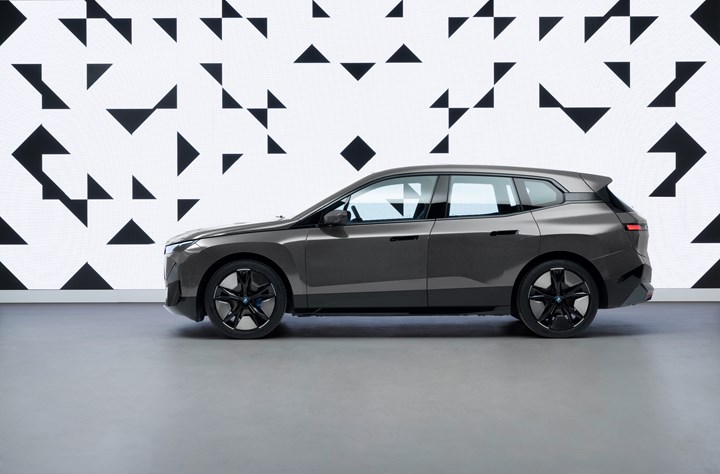BMW has applied a film that uses electrophoretic technology. Or “E Ink,” like what is used on devices like Kindles. Millions of microcapsules in the film have their colors changed as a result of an electrical charge. This provides the ability to change the exterior color as desired.
Photo Credit: All photos courtesy of BMW
While exterior body wraps appear on everything from food trucks to vehicles promoting the latest energy drink (until that wanes and it is replaced with another product), BMW has revealed a crossover, the BMW iX Flow, that is wrapped with a laser-cut material that uses an electrophoretic material, or “E Ink.”
Think of it as what forms the letters on a Kindle.
Embedded in the wrap material are microcapsules—millions of them—which have the diameter approximately equal to that of a human hair.
Inside a capsule are negatively charged white pigments and positively charged black pigments.
Based on the adjustment of an electrical field, sections of the vehicle undergo a color change as the pigments within the capsules migrate to the surface as a result of the charge.
Electrical energy is used only to make the adjustment: it isn’t necessary for it to be “on” all the time in order to maintain the color.

Stylish
Stella Clarke, head of the BMW iX Flow project, says of the E Ink capability, “This gives the driver the freedom to express different facets of their personality or even their enjoyment of change outwardly, and to redefine this each time they sit into their car.
“Similar to fashion or the status ads on social media channels, the vehicle then becomes an expression of different moods and circumstances in daily life.”

Practical
But there is a functional reason for changing the exterior color of a vehicle.
As OEMs like BMW develop and produce electric vehicles, energy savings is a key consideration.
On a hot, sunny day in Phoenix, the interior of a black vehicle is going to be much hotter than a white one due to the absorption of thermal energy.
On a cold day in Minneapolis, the interior of a black vehicle is going to be moderately warmer (we have to be realistic here) than that of a white car, which would reflect thermal energy.
So by being able to make the adjustment of the exterior color based on environmental conditions, the electrical load required by the vehicle’s HVAC system is minimized.
This is actually a big deal. Air conditioning is the largest auxiliary load on a vehicle. While cabin heat in a car with an internal combustion engine is scavenged from the engine (although even then there is energy draw from the blowers), an electric vehicle doesn’t have that source of heat.
Actual
Car and Driver ran tests on a Tesla Model 3 during the winter of 2020 to see the effects of HVAC on energy consumption.
In the first test, the HVAC was off. In the second the system was set to 72° F on auto. In the final test, the HVAC was turned to the max and the five heated seats were set to high.
It was 38° F outside.
The first run with the HVAC off showed a possible range of 234 miles. The second test with the HVAC on resulted in a range decrease of approximately 17%, to 200 miles.
And the max heat put the range down to 173 miles or a 35% decrease from the baseline.
Perhaps the E Ink could help.
Still, this thermally applied wrap isn’t imminent.
Adrian van Hooydonk, head of BMW Group Design, acknowledges, “The BMW iX Flow is an advanced research and design project and a great example of the forward-thinking that BMW is known for.”
It doesn’t require reading between the lines to know that BMW is going to be painting its vehicles for some time to come.
RELATED CONTENT
-
A Current Affair: Examining the "No Amperage" Phenomenon
If you are performing a coating process that requires the use of a rectifier, you may have experienced the "no amperage" problem. Here's a look at the phenomenon and some solutions…
-
Zinc Phosphate: Questions and Answers
Our experts share specific questions about zinc phosphate and pretreatment
-
Understanding Paint Atomization
BASF coatings development expert Tim December explains how paint atomization works for both pneumatic spray applicators and high-speed rotary bell applicators.



.jpg;width=70;height=70;mode=crop)













